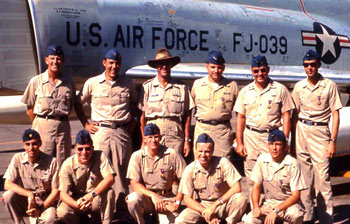Aircraft 039, where are you?
Was 039 a LOSS? or just LOST? or NONE of the above?

Perpetuating mysteries is good fun—so humans do it. Among RF-4C 16th TRS crews, one of those mysteries involves the putative, alleged, or even actual tail number on the right or wrong RF-4C. Our story involves RF-4Cs 64-1039/37/49/47—the tail numbers depend on the raconteur—and what occurred on or about 6 April or 16 April—or perhaps some other April 1966 day.
Whenever it occurred, raconteurs agree: on that day Charles and his Viet Cong minions decided to rain mortar shells on Tan Son Nhut Air Base in general and the 16th TRS aircraft parking area and its environs in particular; and, at least two RF-4s were damaged.
Our guide is Kirk Ransom. Kirk is the indefatigable and unofficial historian of the 16th TRS. (His Web site is www.ransomsroots.com.) He is responding to a question about the provenance of RF-4C 64-1039. Enough of this. Let the story begin:
"As for the two aircraft lost in the first mortar attack at TSN—April 6 or 16, I think. One aircraft took a direct hit in the wing fold. The other in the stabilator. Both aircraft were towed to the 'dump' near the west end of the runway. Each morning when we would taxi in, there would be the two airplanes. Then one day there was only one. A crew had arrived from Hill (Hill AFB, UT-ed.), and overnight they took the tail off of the one that got [it] in the wing fold and replaced the bad tail on the one that took it in the tail.
"The aircraft were either 039 and 049—or 037 and 047. I remember that they both had the same last number. Once they changed the tail they had to change the tail number because, according to the team from Hill, the tail number/serial number is the one on the builder's plate for the aircraft. For the F-4 this was by the front seater's right knee.
"Aircraft 047 is now at the National Museum of the United States Air Force in Dayton.
"Here is the conundrum. None of these aircraft show [on] battle damaged lists or lost aircraft lists. And all four of these tail numbers show up on the schedule board in [an] ops picture of mine taken 20 June 1966. So both must have been 'made whole', the second one with a wing from any old F-4."
The following disputes nothing, but perhaps provides more light than heat to the above: Per Vietnam Air Losses¹ the following occurred on 13 April 1966:
A C-123, 56-4382, assigned to the 315 ACW, USAF, Tan Son Nhut was destroyed. “In the early hours of the 13th, the Viet Cong launched a mortar attack on Tan Son Nhut. This was the heaviest air base attack up to this time with 245 rounds fired from mortars and recoilless rifles, and although only one aircraft was destroyed, about 60 others (including five SP-2H Neptunes of VP-1) received some degree of damage. In addition, 34 vehicles were destroyed or badly damaged and a 420,000 gallon fuel tank was set on fire and destroyed. The damage would have been even worse had not earth revetments been built as a result of earlier experience at Bien Hoa and other bases.”
In August 2010, Kirk, asked about the Vietnam Air Losses’ account, responded: “ Yes that was the mortar attack that took out 037 & 047 (or 039 & 049). If I recall more than 9,000 rounds were expended by the AF SPs (U.S. Air Force base security forces—Ed.) ‘repelling’ the VC hordes. But in the after action report, no VC was ever on the base and on one was hit by a bullet. The Stars & Stripes reported the next day there were two KIA in the barracks when it was hit by a mortar—one fellow on his last day and one who had just arrived that day.
“A number of our guys were walking to the o’club when the attack started and they spent their time in the klong - the sewer ditch on the side of the road.
“Mike C___ was on the flight line when the attack started. He dove in one of the sandbag shelters at the end of one of the revetments. (Out of maybe sixteen revetments, there were only three small three-person sandbag shelters.) There he discovered the shelter was [a] substitute for the 600 yard trip to the latrine.
“After this attack, shelters were erected at the end of each revetment and larger ones beside each hangar. And orders were issued to keep them clean and ready."
1. Hobson, Christopher Michael, Vietnam Air Losses, pg 55. Hinckley, England: Midland Publishing, 2001.
Information attributed to Kirk Ransom, ©2010 by Kirk Ransom; used by permission; Web page ©2010 by Taylor Eubank, Pine Bluff, AR.
